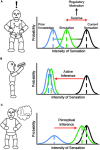Interoception, contemplative practice, and health
- PMID: 26106345
- PMCID: PMC4460802
- DOI: 10.3389/fpsyg.2015.00763
Interoception, contemplative practice, and health
Abstract
Interoception can be broadly defined as the sense of signals originating within the body. As such, interoception is critical for our sense of embodiment, motivation, and well-being. And yet, despite its importance, interoception remains poorly understood within modern science. This paper reviews interdisciplinary perspectives on interoception, with the goal of presenting a unified perspective from diverse fields such as neuroscience, clinical practice, and contemplative studies. It is hoped that this integrative effort will advance our understanding of how interoception determines well-being, and identify the central challenges to such understanding. To this end, we introduce an expanded taxonomy of interoceptive processes, arguing that many of these processes can be understood through an emerging predictive coding model for mind-body integration. The model, which describes the tension between expected and felt body sensation, parallels contemplative theories, and implicates interoception in a variety of affective and psychosomatic disorders. We conclude that maladaptive construal of bodily sensations may lie at the heart of many contemporary maladies, and that contemplative practices may attenuate these interpretative biases, restoring a person's sense of presence and agency in the world.
Keywords: body awareness; contemplative practice; interoception; meditation; mindfulness; mind–body therapies; yoga.
Figures

References
-
- Abdi H. (2007). “Signal detection theory (SDT),” in Encyclopedia of Measurement and Statistics, ed. Salkind N. J. (Thousand Oaks: Sage; ) 886–889.
LinkOut - more resources
Full Text Sources
Other Literature Sources
Medical
Research Materials

